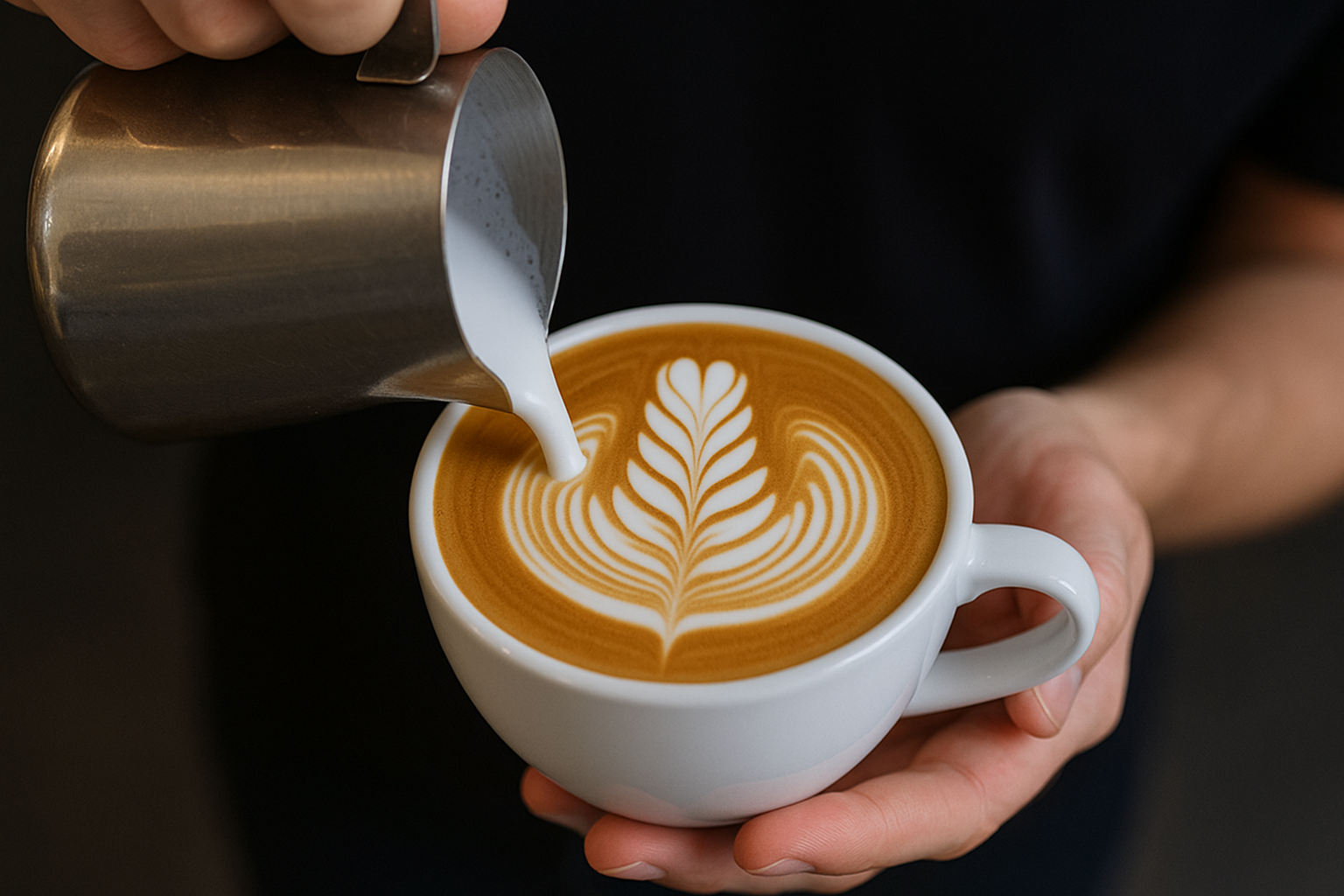Symmetry and balance are what make latte art go from nice to wow.
A perfectly symmetrical heart, a centered tulip, or a balanced rosetta doesn’t just show technical skill — it reflects consistency, control, and precision, which are the marks of a true professional barista.
Whether you’re a beginner still mastering hearts or an intermediate barista pouring tulips and rosettas, learning how to improve symmetry and balance in every pour is one of the most valuable skills you can develop. The good news? It’s not magic — it’s technique, awareness, and repetition.
In this detailed guide, you’ll learn what symmetry and balance actually mean in latte art, the key techniques that influence them, the most common mistakes that throw off your pours, and step-by-step strategies to improve both as you grow.
Let’s help you pour latte art that’s not just pretty — but perfectly placed.
What Are Symmetry and Balance in Latte Art?
Before we jump into technique, let’s define the terms:
- Symmetry refers to how even your design is across a central line — for example, both sides of a heart being equal in shape and size.
- Balance relates to placement and proportion — how well your design fits within the cup, how centered it is, and how evenly spaced each element looks (especially in tulips and rosettas).
A symmetrical and balanced design looks:
- Centered in the cup
- Evenly shaped on both sides
- Appropriately sized (not too small or too large)
- Aligned with the cup’s handle (for service aesthetics)
- Proportional from top to bottom
Even if you’re pouring complex designs, they’ll lose visual appeal if they’re off-center or uneven. Symmetry and balance are the finishing touches that elevate your pour.
Why Symmetry Matters in Latte Art
Symmetry is more than just visual flair — it’s the result of:
- Good milk texture
- Consistent pour speed and angle
- Strong hand stability
- Mastery of pitcher control
- Proper positioning of both your cup and your wrist
The more symmetrical your design, the more control you demonstrate — which is essential in competitions, café service, or showcasing your portfolio.
Plus, symmetry makes the drink look intentional. When you hand it to a customer, it communicates quality and pride in your craft.
Foundations for Better Symmetry
Let’s explore the fundamentals that support clean, balanced pours.
1. Cup Positioning
- Keep the cup level and angled slightly toward you (around 20–30°).
- Hold it by the handle or the bottom, depending on your comfort.
- Make sure the cup is stable and centered in your hand.
If the cup is tilted awkwardly or bouncing around, your design will reflect that instability.
2. Pouring Centered
- Always pour into the center of the cup.
- When creating designs, your stream of milk should land on the central axis.
- Keep your wrist steady to prevent drifting.
Drifting to the left or right causes uneven shapes and distorted symmetry — a common mistake, especially in rosettas.
3. Controlled Flow Rate
The speed of milk flow should be even and intentional. Fast pouring can cause milk to spread too quickly and create lopsided art. Slow, steady flow gives you more control.
Use flow rate to shape your design. Mastery of flow lets you expand or contract each part of the pattern evenly.
4. Milk Texture
Your milk must be properly steamed — shiny, smooth microfoam with no visible bubbles.
Poor milk texture results in foam that doesn’t flow evenly, breaking up your design and destroying symmetry.
Aim for:
- 60–65°C temperature
- Tight vortex during steaming
- Consistent swirl before pouring
Always swirl the milk before pouring to keep the foam integrated.
5. Pouring Height and Movement
High pour = thin stream = blends with crema
Low pour = thicker stream = sits on surface and creates design
Symmetry depends on how long you stay in each height and how stable your hand is. Pouring too high or low at the wrong time ruins definition.
Techniques to Improve Symmetry in Specific Designs
Each latte art design has its own flow, but the principles of symmetry apply across all of them.
Hearts
- Begin your pour dead center.
- Lower your pitcher as the cup fills and increase flow rate for the white dot to appear.
- Keep the pour still — no wiggling.
- Finish by pulling the stream through the center.
Pro Tip: If your heart is leaning, you’re likely moving your hand during the final draw. Pull in a perfectly straight line.
Tulips
- Start in the center with a small pour.
- “Stack” layers by lifting slightly and re-entering the center with each new layer.
- Be mindful of spacing — each shape should be even in size and distance.
Pro Tip: Use stop-start control in your flow to prevent the white shapes from bleeding into one another.
Rosettas
- Begin with a slow, high pour to integrate the milk.
- Lower the pitcher and begin a wiggle motion from left to right.
- Keep your hand movement even and rhythmic.
- Draw through the center to form the stem.
Pro Tip: If your leaves are uneven or break apart, your wiggle speed may be inconsistent. Keep your wrist relaxed and steady.
How to Practice Symmetry and Balance
Improving symmetry takes repetition and awareness. Here are practical steps to build muscle memory and visual accuracy.
1. Use Visual Guides
Draw a straight line down the center of a practice cup with a marker or piece of tape.
This helps you aim your pour and adjust your alignment.
2. Film Yourself
Set your phone to record your pour from above.
Watch how your hand moves. Are you drifting? Tilting? Speeding up randomly?
Reviewing footage helps you correct errors faster than guesswork.
3. Practice with Water and Soap
Fill your pitcher with warm water and a drop of dish soap.
It mimics milk’s viscosity and lets you practice without waste.
Try pouring the same design 10 times and aim for consistency and central alignment.
4. Use the Same Tools Every Time
Practice with the same cup, same pitcher, and same amount of milk.
This removes variables and helps you isolate your technique.
5. Pour with Both Hands (Optional)
Some baristas practice symmetry by pouring with their non-dominant hand.
It builds awareness of muscle control and strengthens your primary hand technique.
Common Symmetry Mistakes (And Fixes)
Mistake 1: Design is off-center
Cause: Hand drift or cup tilt
Fix: Keep your elbow close to your body and aim straight into the center
Mistake 2: One side is bigger or bolder than the other
Cause: Uneven flow or inconsistent milk texture
Fix: Swirl milk before pouring and maintain a steady wrist
Mistake 3: Design leans or spirals
Cause: Rotating the cup mid-pour or moving hand in an arc
Fix: Pour straight and finish with a centered draw-through
Mistake 4: Rosetta leaves are uneven
Cause: Inconsistent wiggle speed
Fix: Practice a smooth back-and-forth motion at the same depth and width
Mistake 5: Shapes are stacked unevenly in tulips
Cause: Starting new shapes off-center
Fix: Reset your hand position before starting each new push
Mental Focus and Body Positioning
Latte art is a physical movement — but it also requires concentration and posture.
- Stand square to the machine or counter
- Keep your wrist relaxed and your hand steady
- Breathe slowly to avoid rushed or shaky movements
- Focus on intentional placement, not just pouring fast
You’re not just pouring milk — you’re guiding the shape into place.
Design Symmetry vs. Natural Flow
It’s important to remember that symmetry isn’t perfection. A perfectly symmetrical pour can look robotic. In contrast, slight imperfections often make a design feel more organic and hand-crafted.
Your goal isn’t absolute perfection — it’s balance and intention.
The best baristas can pour quickly and consistently while keeping their designs centered, clean, and full of personality.
Tips from Professional Baristas
We asked a few pros what helped them improve symmetry:
- “Slow down. Pouring fast doesn’t mean better.”
- “Stare at the center of the cup — not your pitcher.”
- “Always finish strong. A clean draw-through saves the whole design.”
- “Consistency matters more than complexity.”
- “Don’t be afraid to dump and redo. One clean pour is better than five sloppy ones.”
Final Thoughts: Symmetry Is a Skill You Build, Not a Talent You Have
Perfectly balanced latte art isn’t just for competitions or Instagram. It’s a reflection of your focus, intention, and respect for your craft.
Every time you pour a symmetrical design, you show that you understand your tools, your milk, and your own hand. You build confidence. You create consistency. And you raise the level of service and care that your customers experience.
So keep practicing. Record your progress. Celebrate your improvements. Symmetry takes time — but every clean pour brings you closer to mastery.

Marcelo Rodrigues is a passionate barista with over 7 years of experience in specialty coffee. He’s worked in top cafés, led barista training sessions, and now shares practical tips to help beginners and coffee lovers improve their skills. Through this blog, Marcel makes the world of coffee more accessible—one cup at a time.

